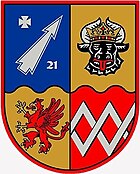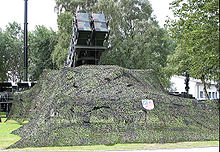Anti-aircraft missile group 21
|
FlaRakGrp 21 Wappen.jpg |
|
|---|---|
 Coat of arms of FlaRakGrp 21 |
|
| Lineup | September 1, 1959 |
| Country |
|
| Armed forces |
|
| Armed forces |
|
| Branch of service | Air defense |
| Insinuation |
|
| garrison |
|
| Web presence | FlaRakGrp 21 |
| guide | |
| Commodore | Lieutenant Colonel Markus König |
The anti-aircraft missile group 21 (FlaRakGrp 21) is one of three patriot groups of the anti-aircraft missile squadron 1 (FlaRakG 1) of the German armed forces .
History and locations
The anti-aircraft missile group 21 has its origin in the anti-aircraft missile battalion 21, which was put into service in April 1959 in Fort Bliss , Texas and at the Cologne-Wahn air base . Cologne-Wahn was the first German installation site, but as early as 1959 the aim was to relocate the association to the Iserlohn, Soest, Warendorf and Dülmen areas. The newly established anti-aircraft missile battalion 21 was the first unit of the air force to receive the new “ Nike Hercules ” weapon system . In the summer of 1959, intermediate locations in Gelsenkirchen-Buer and Bocholt were already occupied. The takeover of “ Schloss Erwitte ” near Soest at the end of 1959 was remarkable , after the Bundeswehr had acquired this property for 1.6 million DM.
In the following years, the deployment positions were established at the locations in Westkirchen (Münsterland, 1./21), Datteln (4./21) and Holzwickede (Ruhr area, 3./21). The deployment positions were integrated into NATO's FlaRak belt, which arose from the North Sea to Bavaria to ward off a potential attack from the east. At seven to nine Nike Hercules missiles were nuclear warheads the US Army mounted. For maintenance and guarding, US soldiers were stationed in the launch area or in a barracks in Büecke.
In 1970 the Möhnesee - Echtrop location was added after the Canadian armed forces had withdrawn from there. In Möhnesee the FlaRak Battalion 21, staff, staff unit, supply unit, air force medical unit and the 2nd / 21st were located. The barracks, known as Fort York, were named Graf-Yorck barracks in 1973 ; despite the similarity, both names have no relation to each other.
In the second part of the 1980s, the Sauerland barracks ( Lennestadt-Oedingen im Sauerland, 5./21) and Waldbröl (Bergisches Land, 6./21) were added from the FlaRakBtl 22 area. With its now six individual locations, the anti-aircraft missile group 21 was at the end of the 1980s the most widely deployed anti-aircraft missile unit of the Air Force. All locations were in the federal state of North Rhine-Westphalia .
The NIKE weapon system shaped the identity of the anti-aircraft missile battalion 21 until 1986. Numerous inspections (ORE, NWTI) and shift work were part of everyday military life for many members of the association for almost 30 years. Even a restructuring in 1987 could not change this, when the anti-aircraft missile battalion 21 became a squadron for a short time .
With the introduction of the MIM-104 Patriot weapon system in 1990, the anti-aircraft missile squadron 21 was again a pioneer in the field of air defense. As the first squadron in Westkirchen the 1./21 was equipped with the new weapon system. As early as July 1990, the anti-aircraft missile squadron 21 reported the operational readiness of the first half-squadron (1st / 2nd / 2nd / 3rd and 3rd / 21st) after the conversion was completed. A reorganization finally brought about the anti-aircraft missile group 21 with its six locations in North Rhine-Westphalia in 1993, as they were to exist until 2002.
With the further adaptation of the air force structure 5 , Bad Arolsen only formed a transitional location in the 40-year history of the anti-aircraft missile group 21. In January 2004, an advance command was set up at the new location in Sanitz in Mecklenburg-Western Pomerania. Soldiers from the most varied of sectors prepared in cooperation with the soldiers of the to be disbanded anti-aircraft missile group 12 to take up the PATRIOT weapon system. In April 2004, a strongly reinforced advance command replaced the advance command. The long era of ground-based air defense in North Rhine-Westphalia ended on June 25, 2004 with a large closing roll call in Möhnesee-Echtrop.
The anti-aircraft missile group 21 was subordinate to the anti-aircraft missile squadron 4 (dissolved) in Burbach together with the anti-aircraft missile group 25 until December 17, 2003 , then together with the anti-aircraft missile group 24 to the anti-aircraft missile squadron 2 in Bad Sülze .
On June 1, 2004, the staff, the staff relay and the 1st and 2nd relay at the Sanitz site in the Siebenbuche barracks, and the supply relay and the 4th and 5th relay in the Prangendorf barracks were reorganized. For a transitional period, the 3rd squadron was set up in Bad Sülze in the Recknitztal barracks and dissolved on June 30, 2006.
Today's anti-aircraft missile group 21 was set up in a solemn roll call on June 30, 2004 in Sanitz ( Mecklenburg-Western Pomerania ) as the first Patriot Association in the new federal states. The staff of the old FlaRakGrp 21, which was deployed at the Möhnesee ( North Rhine-Westphalia ) and Bad Arolsen ( North Hesse ) locations, was merged with the FlaRakGrp 12 located there at the Sanitz and Prangendorf locations .
On July 1, 2006, the 5th season was renamed the 3rd season. The capture of air force structure 5 was thus completed for anti-aircraft missile group 21. The FlaRakGrp 21 thus emerged from the FlaRakGrp 21 (old) and the FlaRakGrp 31/12.
In December 2006 the association was certified together with the anti-aircraft missile squadron 2 and the anti-aircraft missile group 24 as part of an operational evaluation (OpEval) by NATO for the NRF -9 standby phase from July 1, 2007 to January 18, 2008 .
On June 27, 2007, the Prangendorf barracks were renamed Graf-Yorck-Kaserne in the presence of the former ambassador Yorck Graf von Wartenburg . In April 2009, the anti-aircraft missile group 21, the Air Force's oldest anti-aircraft missile unit, turned 50. On March 8, 2013, the anti-aircraft missile squadron 2 was disbanded. Its two groups 21 and 24 were subordinated to the anti-aircraft missile squadron 1 .
literature
- Wilhelm von Spreckelsen, Wolf-Jochen Vesper: Blazing Skies - The history of the air defense missile troops . Isensee Verlag, Oldenburg. ISBN 3-89995-054-2


